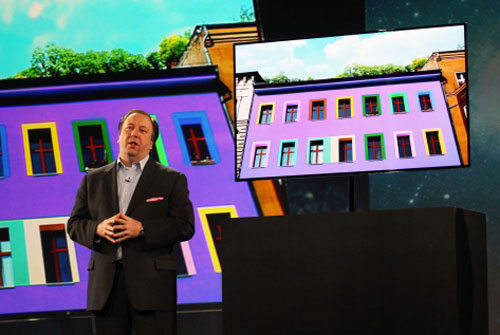
Both LG Electronics and Samsung Electronics used the 2012 Consumer Electronics Show (CES) event in Las Vegas this week to introduce 55-inch OLED (organic light-emitting diode) television sets. But the technology is far from new.
Research into causing organic materials to emit light electrically has been going on for more than 20 years, with the increased attention currently being paid to OLED signifying that at last researchers have begun to discover organic materials that possesses the light emission efficiency and durability suitable for use in illumination and displays.
It was, in fact, Eastman Kodak scientists who, in the 1970s, patented OLED technology after they had been experimenting with solar cells and noticed a blue glow. In 2009, Kodak sold all the assets of its OLED business to LG, signing a full cross-patent agreement, giving both parties access to the other’s substantial patent portfolios.
Over the past decade, various leaps forward have been made in the development of OLED technology, notably concerning the longevity of colours and issues concerning “dead pixels” on larger models. Though a small OLED TV launched by Sony failed to catch on in the past couple of years (due no doubt to price), Samsung has been broadly using OLED technology in its SmartPhones in recent times.
This week’s news from Samsung and LG created a big buzz at CES. The Samsung “Super OLED TV” is acclaimed by the manufacturer as delivering the “ultimate in picture quality”. The set features elegant design, dual-core processor and Smart Interaction technology.
Super OLED technology eliminates the need for a colour filter, as the OLED pixel unit comprises self-emitting RGB sub-pixels laid directly on the display panel, each emitting its own light. The technology is also able to differentiate varying degrees of blacks and shadows, so that users can enjoy greater detail even in the darkest of scenes. Super OLED offers faster response times than LED, virtually eliminating motion blur even in the fastest-moving scenes.
Because Super OLED technology features self-emitting RGB sub-pixels which do not require a back light, the TV weighs significantly less than a standard LED-backlit TV.
In its Las Vegas press conference, Samsung also announced that consumers will be able to use new Smart Interaction technology to manage their TV experience. By using voice control, motion control and face recognition features to complement the remote control, users can turn the TV on or off, adjust the volume or activate selected apps through speech. They can also use voice to activate the search function in the Web browser and “tell” the TV what they are searching for.
The Super OLED’s built-in camera recognises movement in the foreground to enable intuitive control, and two unidirectional array microphones recognise voice. Noise cancellation technology helps to separate any background noise from the users’ commands. — Consumer Lifestyle News (www.cln-online.org)
- Subscribe to our free daily newsletter
- Follow us on Twitter or on Google+ or on Facebook
- Visit our sister website, SportsCentral (still in beta)




